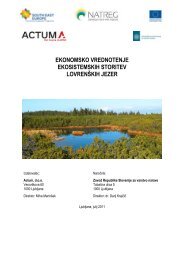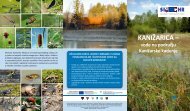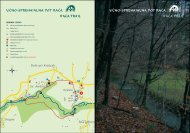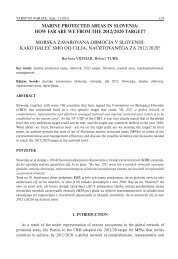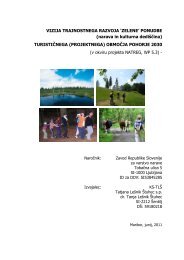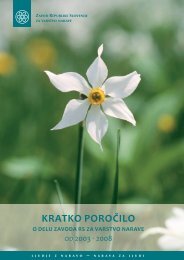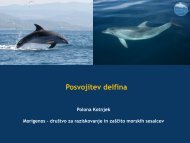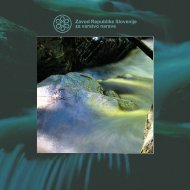Monitoring MPA visitor uses handbook
Monitoring MPA visitor uses handbook
Monitoring MPA visitor uses handbook
- No tags were found...
Create successful ePaper yourself
Turn your PDF publications into a flip-book with our unique Google optimized e-Paper software.
Gaining knowledge to improve managementof diving activities and their impacts: theexample of the Medes Islands <strong>MPA</strong>(Montgrí, Medes islands and Baix Ter NaturalPark - Spain)Located less than one kilometre off the coast of Estartitholiday resort in Spain, the Medes Islands have longbeen a very popular diving spot in the Mediterranean.Introduced in 1990, a Use Plan and specific regulationsgovern the activity to avoid all excessive diving and allpotential harm to the outstanding offshore environment.Facilities and measures to control numbers have beenput in place, restricting the number of divers to 450 perday, all year round, across the 10 diving sites specificallylaid out (fixed mooring facilities). However, to improvemanagement of the activity, in recent years the managerswere keen to have qualitative data about divers' use ofthe marine area. A study was therefore carried out incooperation with the diving centres to precisely identifythe diving trails, the way dives are conducted and thebenthic communities they like to explore.The results were obtained through 88 exploratory divesand group monitoring over one summer. In addition toidentifying general diving characteristics in the Medes(average depth of 26.7 metres, lasting 51 minutes,covering an average distance of 485 metres), the study ofdivers' use of the area is particularly interesting in termsof management. It showed that divers use almost 8 ofthe 51 hectares protected. This information provides alead for studying changes to certain species based onthe degree of diver use. Moreover, species indicative ofa low rate of use were identified. The study also revealedthat caves have the highest environmental risk factor (linkbetween diver presence and vulnerability), while 37% ofdives in the Medes take place in that kind of environment.The organisation of diving therefore needs to be managedbased on the risk factor. Lastly, the study highlightedthe importance of awareness-raising and informationprovided by diving clubs to reduce the activity's impacton benthic communities.Reference : Núria Muñoz, 2007, Spatial use and divers'behaviour in the Medes Islands, field study, MedPANreport, 137 p.5.7 Qualitative monitoring indicatorsby user surveysUsing a common protocol, a survey by questionnaireprovides data for three indicators. The qualitative dataobtained is essential to determine the characteristics ofusers, their activities, their opinions and their stance withrespect to the <strong>MPA</strong> regulations. They relate to the differentcategories of <strong>MPA</strong> users (pleasure boaters, boattransport passengers, divers, etc.), whether <strong>visitor</strong>s orlocals.Distribution of a questionnaire (multiple choice questions) on Port-Cros harbour(France). © Credit: LETG Brest-Géomer.5.7.1 Relevance of the User profiles andactivities indicatorThis indicator aims firstly to identify the characteristicsof user populations in the <strong>MPA</strong>: age, socio-professionalgroup, main place of residence, place and length of stay,loyalty to the site (number of previous visits, date of thefirst visit, desire to come back), means of transport, etc.All this information is particularly useful for implementingeffective communication.Secondly, it provides understanding of user centres ofinterest (relaxation, nature discovery, fishing, sailing,museums, restaurants, etc.) and the activities they do.An analysis of this data will aim to assess the degree towhich the activities actually done match <strong>visitor</strong> expectations,and to highlight the <strong>MPA</strong>'s main centres of attraction.5.7.2 Relevance of the User perceptionand satisfaction indicatorThis indicator is designed to assess user satisfactionwith respect to the activities they have done, the qualityof services available (or not), and their opinion of thelandscape and the environment, etc.It also aims to define the relationships that exist between<strong>MPA</strong> users through two key questions :• Would you say that the number of <strong>visitor</strong>s to the site is : high medium low ?• Do you find <strong>visitor</strong> numbers : acceptable inconvenient no opinion ?These questions may be asked about the entire <strong>MPA</strong> ortarget one or more specific areas (diving sites, beaches,mooring sites, coastline paths, etc.). This indicator alsomeasures user tolerance of <strong>visitor</strong> numbers and highlightsany conflicts of use. TABLE OF CONTENTS 30 COLLECTION VISITOR USE OBSERVATION AND MONITORING IN MEDITERRANEAN MARINE PROTECTED AREAS



